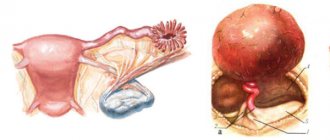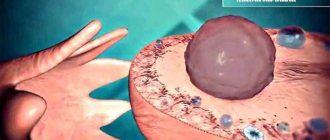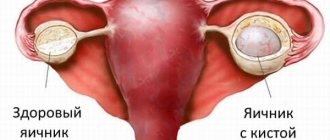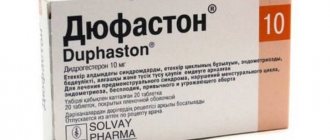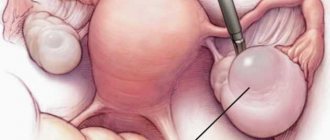Last update: 09/19/2019
The ovaries are a very important organ in the female reproductive system. It is in them that future eggs are born, which at conception meet with sperm. One of the causes of infertility can be a cyst - a benign neoplasm with thin walls filled with fluid. But this diagnosis is not a death sentence. If you consult a doctor in a timely manner, you can quickly cope with the disease. As a treatment course for ovarian cysts, the doctor may prescribe the drug Duphaston.
- Types of ovarian cysts
- Symptoms
- How to take duphaston
- Prevention of female diseases
Some cysts require only observation, others require surgery.
Approximately 40% of women are diagnosed with ovarian cysts. The reasons for the formation of cysts are not fully understood, but risk factors associated with hormonal imbalance have been identified:
- diseases of the genital organs, bladder or intestines;
- irregular menstruation;
- obesity;
- endocrinological problems;
- abortions;
- untimely taking of medications.
It is imperative to follow the doctor’s recommendations and not rely on chance.
The essence of pathology
From Greek, the word “cyst” is translated as “bag”. Such a neoplasm can be single or multiple.
A cyst can form on one ovary (usually on the right) or be bilateral.
The pathology varies in size - from a few millimeters to 20 centimeters.
IMPORTANT!
Some cysts, in the absence of adequate treatment, can transform from benign to malignant.
Since cystic formations are a large group, they are classified according to the reason for their occurrence and the nature of the contents:
- follicular - develops as a result of the absence of rupture of the follicle;
- paraovarian - appears not on the ovaries themselves, but on their appendages, characterized by very rapid growth and enormous size;
- corpus luteum cyst – the pathological process starts in the absence of regression of the corpus luteum;
- dermoid - a congenital cyst that begins in the embryonic period;
- endometrioid - formed during a strong inflammatory process in the uterine lining;
- mucinous - the fluid contained in the cavity of this neoplasm is represented by thick mucus, which is synthesized by the cyst shell.
Cyst treatment can be carried out in two ways - conservative or surgical.
Surgical treatment of tumors requires certain indications, and doctors are trying their best to achieve resorption of the cyst without surgery - with the help of medications. As a rule, these are hormone preparations, one of which is Duphaston.
Description of the drug
Duphaston is a drug that, in its structure, effects and pharmacology, is an analogue of the natural hormone progesterone.
The active and active substance of this drug is dydrogesterone, which contributes to the fact that the endometrium moves from phase 1 of the cycle to phase 2, as a result of which there is no pathological growth of endometrial tissue, that is, hyperplasia does not develop.
Dydrogesterone is not a derivative of the hormone testosterone, which means that the drug does not have side effects that can often be observed when taking androgenic progesterones. For example, the appearance of masculine traits. In addition, this product does not retain fluid in the body and does not contribute to weight gain.
When taking the drug, the too active effect of estrogen is muffled, however, the anti-atherosclerotic properties of this hormone are preserved.
As for the mechanism of action of Duphaston for ovarian cysts, it is simple.
Cystic neoplasms, as a rule, begin to form due to hormonal imbalances in the body. When estrogen is synthesized too actively, the production of progesterone decreases, as a result, a woman experiences disturbances in her monthly cycle, develops endometriosis, and so on.
Therefore, in order to reduce the synthesis of estrogen and increase the concentration of progesterone to a normal level, gynecologists recommend taking Duphaston. As soon as a woman’s hormonal background improves and stabilizes, those neoplasms that are able to resolve regress.
NOTE!
You need to understand that not all cystic neoplasms are the result of hormonal imbalance, so not all cysts can be treated with Duphaston. Self-administration of this drug is prohibited; it can only be prescribed by a doctor after a thorough diagnosis of the patient.
Contraindications for use
Not all patients can use the medication. That is why only the attending physician should prescribe the drug. Contraindications for treatment with this drug are the following:
- Individual intolerance to the active substance or additional components included in the medicine.
- Severe liver pathologies.
- Malignant neoplasms.
- Deterioration of blood clotting.
The medication can also be used by pregnant women, but this must be prescribed by the treating doctor. It is not recommended to use the medicine during breastfeeding, since dydrogesterone penetrates into the milk and then into the baby’s body. For children, this drug is prescribed if an ovarian cyst is detected.
Cyst treatment
This drug is often prescribed for the treatment of cystic ovarian pathologies - it is used for the treatment of follicular, endometrial and other cysts, the causes of which are hormonal imbalances.
Duphaston is also prescribed for polycystic ovary syndrome, irregularities in the menstrual cycle and loss of fertility.
According to patient reviews, Duphaston not only quickly eliminates the clinical picture, which will branch out in the presence of benign neoplasms, but also has a detrimental effect on cyst cells. After just a few cycles of taking the drug, small cysts can be completely eliminated.
Expert opinion
Shustova Olga Leonidovna
Obstetrician-gynecologist of the highest category
Duphaston is a drug from the group of gestagens, which is actively used by gynecologists to treat many female diseases associated with hormonal imbalances. It is important to remember that treatment with hormonal drugs, including Duphaston, should be carried out under the supervision of a doctor, since these medications have contraindications, and uncontrolled use can provoke a deterioration in a woman’s health. Most often, Duphaston is prescribed for the treatment of luteal, follicular and endometrioid cysts, but only if the pathology proceeds without complications. The action of the drug is based on an increase in the concentration of progesterone, as a result of which the pituitary gland stops the production of estrogen, which in turn leads to the cessation of nutrition of the cyst and its death.
Prevention of female diseases
- regular observation by a doctor;
- treatment of inflammatory diseases;
- taking hormonal medications in accordance with the instructions;
- a diet developed by a specialist for you;
- refusal of abortion;
- avoiding solariums and exposure to direct sunlight.
Ovarian cyst is a difficult and even insidious disease. If you do not see a doctor in time, it can lead to infertility, cancer and other complications. So prevention is always better than cure. Take care of yourself and be healthy!
Operating principle
Ovarian cysts can be pathological or functional, and the treatment of the disease depends on the type of tumor.
As is already clear from the above, Duphaston is an artificial progesterone that is directly involved in changing the phases of the menstrual cycle.
Some people think that this property of Duphaston will suppress ovulatory processes, but this is not true. For the treatment of cystic neoplasms, Duphaston is prescribed in the second phase of the cycle, and by this time ovulation has already occurred.
When treating follicular cysts, Duphaston affects the concentration of estrone and progesterone, which entails regression of the follicular neoplasm. During the treatment of a corpus luteum cyst, the drug suppresses the secretion of luteinizing hormone produced by the cyst, which also leads to the resorption of the formation.
Artificial progesterone also helps well with cysts of endometrioid origin. In this case, the drug will prevent excessive growth of the endometrium, which will allow it to enter the secretory phase, but in this case it will not be possible to eliminate the cyst itself - its growth will slow down, but no more.
Types of ovarian cysts
- Endometrioid The fact that a cyst has appeared in the uterus is indicated by unpleasant sensations during menstruation.
- Corpus luteum cyst A woman may not even be aware of its presence, since the tumor may not attract attention to itself. The tumor appears when the egg becomes a corpus luteum filled with fluid.
- Follicular May appear in a woman during ovulation and disappear soon after several menstrual cycles. Usually the tumor does not need to be treated. But observation by a doctor is mandatory.
- Hemorrhagic The effusion of blood into a follicular cyst becomes the cause of such a tumor.
- Dermoid This dangerous tumor can reach 15 cm in diameter. The first symptoms are sharp pain. It is useless to treat it with pills and suppositories. Usually, the attending physician recommends going to the hospital for surgery to remove the cyst.
- Cystodenoma Cyst can arise from ovarian tissue.
- Polycystic ovary syndrome is the appearance of not one, but several cysts on the ovaries. These tumors interfere with the normal functioning of the female organ and prevent a woman from becoming a mother. Benign neoplasms occur in women not only in the ovaries, but also in the breasts. For example, with fibrocystic mastopathy (a disease in which the histological structure of tissues is disrupted), patients are recommended to undergo regular mammography. The causes of mastopathy can be abnormalities in the endocrine system, early menstruation, lack of childbirth, stress, and more.
Advantages and disadvantages
The drug has the following advantages:
- treats endometriosis;
- relieves infertility (which is caused by luteal insufficiency);
- relieves premenstrual syndrome;
- restores the cycle;
- eliminates some types of cystic neoplasms;
- easy to use;
- has a small list of contraindications;
- rarely causes side effects.
As for the disadvantages, one can note its relatively high cost, especially considering that therapy can take several months.
What is Duphaston prescribed for?
Medicines like Janine and Duphaston are prescribed after laparoscopy to resolve several issues.
- They correct the condition of the endometrium and reduce the rate of cell proliferation. Consequently, the patient can count on the fact that they will not begin to grow again after surgical treatment. True, it also depends on the dosage of the drug; you need to choose it correctly.
- Restoration of hormonal levels. Indirectly. Because Duphaston does not have direct estrogenic activity. The same cannot be said about its analogues, for example, Janine. Therefore, you need to look at what kind of medication is prescribed.
- Restoring the normal menstrual cycle. Ovulatory. With the maturation of a full-fledged egg.
In some cases, drugs are prescribed to patients during pregnancy. Duphaston does not affect childbirth. There will be no consequences after laparoscopy.
Thus, Duphaston is a maintenance drug that accelerates the restoration of reproductive function and also increases the likelihood of becoming pregnant.
Indications and instructions for use
The drug is prescribed to patients for:
- endometriosis;
- lack of conception;
- spontaneous abortions;
- pronounced premenstrual syndrome;
- monthly cycle failures;
- dysfunctional uterine bleeding;
- cystic formations associated with hormonal imbalance.
IMPORTANT!
Before you start taking this drug, you must undergo a thorough examination, which includes a blood test for hormones. The patient must understand that taking the drug for various pathologies is strictly individual and sometimes may not correspond to the regimen described in the package insert.
As a rule, in the presence of ovarian cysts, the drug is prescribed 1 or 2 times a day from the 14th to 25th day of the menstrual cycle. This is necessary to maintain progesterone levels at the proper level in the second phase. Thus, ovulation proceeds normally, existing cysts involute and the development of new formations is prevented.
The medicine should be taken in the morning and evening with water.
Reviews
Marina, 28 years old (Moscow): I periodically suffer from inflammation of the ovaries, and when I went to the hospital again with this problem, the doctor, after an ultrasound, reported that a cyst had appeared. They only cured the inflammation, and sent me to my gynecologist with the cyst. She prescribed Duphaston: take it for three months in a row from days 15 to 25 of the cycle. I don’t know how it is in other clinics, but the doctor prescribed the drug without hormonal tests. I didn’t even know they were needed, but I recommend everyone to demand a full examination from their gynecologists.
I tried to take the medicine strictly on schedule, at the same time of day. Almost immediately after taking the pills, my breasts began to ache and enlarge, and on uncharacteristic days. This lasted two months, and during the third cycle there were no side effects. After stopping Duphaston, I was sent for an ultrasound, and no cyst was found, everything went away. After my experience, I can recommend Duphaston as an effective remedy, but it is important that the doctor refers patients to hormonal studies before prescribing the drug.
Anastasia, 25 years old (Vladimir): I went to the doctor because it hurt during intimacy, as well as when I suddenly sat down or stood up. The doctor sent me for an ultrasound, which showed the presence of a cyst in the ovary, but did not prescribe any medications, but advised me to wait for menstruation. I explained this by saying that for many cysts appear and go away on their own in 1-2 cycles.
A month later, an ultrasound revealed that the cyst had shrunk, but had not disappeared completely, and there were also many follicles that had increased in size and could also turn into a cyst in the future. And they prescribed Duphaston for six months. I decided to play it safe and turned to another doctor. The result was almost the same: Duphaston course for 3 months. After 3 months, an ultrasound revealed clean ovaries without traces of a cyst! In addition, ovulation, which previously had problems, has returned to normal.
Natalya, 33 years old (Samara): Duphaston punched a hole in my budget, but without it it would have been much worse. They diagnosed endometriosis and immediately prescribed Duphaston, 1 tablet twice a day from days 2 to 25 of the cycle. At the same time, an ultrasound scan revealed a cyst of such a large size that I had to go to oncology. There they looked for metastases for 4 months, as they suspected the presence of lymphoma, which oncologists did not confirm and gave the go-ahead for surgery. Before the operation, a repeat ultrasound was performed: thanks to Duphaston, the cyst did not grow even larger, despite many months of tests and waiting
Side effects
Due to the characteristics and individuality of the female body, some patients may experience the following side effects:
- migraines and nausea;
- increased gas formation;
- allergic urticaria;
- change in blood formula;
- uterine bleeding.
But most often, Duphaston is well tolerated by patients and, without causing harm to the woman’s body, gives a positive effect in the treatment of a large number of diseases of the reproductive system.
Side effects and contraindications
The drug can provoke negative responses from the body in response to the treatment. The use of Duphaston for the treatment of cysts without the approval of a doctor is prohibited - in order to avoid the development of non-standard reactions.
Contraindications for use
The medication is prohibited for use under the following conditions:
- with a high level of sensitivity to the component composition of the drug;
- during other treatment options for formed cysts in the ovaries;
- in cases of liver dysfunction;
- with low levels of blood clotting indicators.
Increased caution is necessary when combining Duphaston with estrogens, as a means of hormone replacement therapy, for patients with diseases:
- with diabetes mellitus;
- attacks of headaches;
- diseases of the cardiovascular department;
- with epilepsy;
- impaired renal function.
Side effects from taking
Therapeutic manipulations can provoke some non-standard reactions of the body:
- attacks of migraine, headache;
- increased level of sensitivity to the constituent components;
- symptomatic signs of hemolytic anemia;
- allergic manifestations - rashes, obsessive itching, reddish stripes, in complex cases - Quincke's edema;
- increased breast sensitivity;
- spontaneous bleeding from the uterus;
- minor deviations in liver function, with a state of general malaise and weakness.
The formation of widespread tissue swelling is recorded in rare cases.
